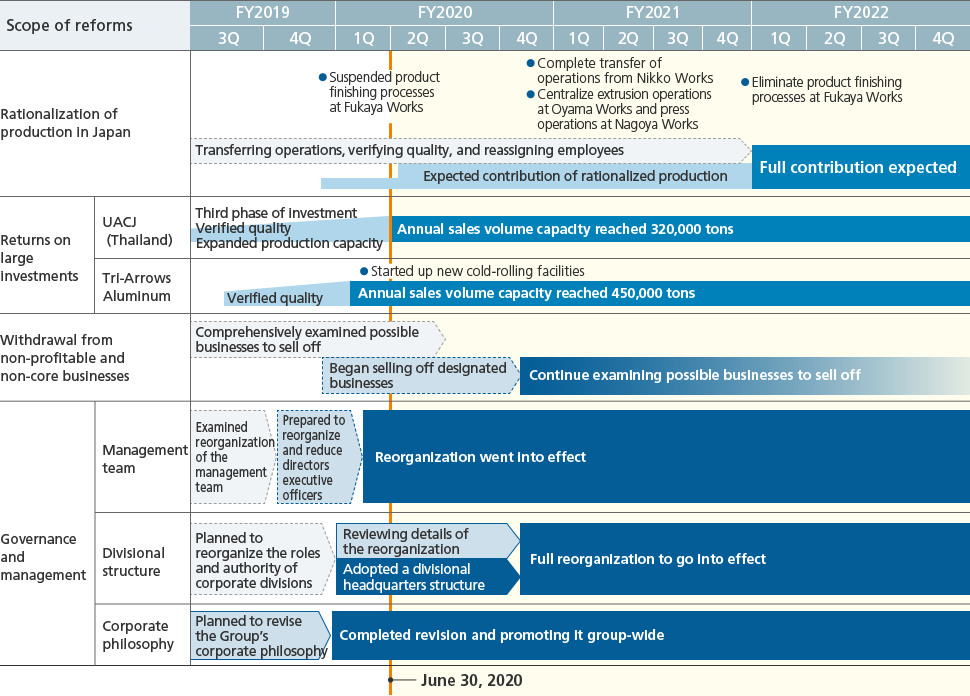- Katsuyasu NiiboriDirector and Managing Executive Officer
In charge of Chief Executive of Corporate Strategic Restructuring Office, Chief Executive of Corporate Strategy Division - In the lead-up to UACJ’s establishment, Katsuyasu Niibori was in charge of the department handling the merger at Furukawa-Sky Aluminum Corporation. Later he served as president of UACJ Foil Corporation. When structural reforms were announced in September 2019, he was tasked with leading UACJ’s Corporate Strategic Restructuring Office, and then appointed as the head of the Corporate Strategy Division when the Company reorganized in April 2020.
 What was the background for UACJ’s structural reforms?
What was the background for UACJ’s structural reforms? We decided on drastic structural reforms to make the Company strong enough to withstand sudden changes in the operating environment.
We decided on drastic structural reforms to make the Company strong enough to withstand sudden changes in the operating environment.
UACJ was established through the merger of Japan’s top two aluminum product manufacturers, which aimed to form a major global company. When the merger was decided, I remember the excitement among our members as we all imagined how to create a unique new business.
As we had envisioned, UACJ grew into a leading global manufacturer after proactively investing in business expansion, not only in Japan but also in Thailand and the United States. Before reaching a phase when those large investments could produce returns, however, demand for our products dropped due to trade friction between the U.S. and China, and aluminum ingot prices and foreign exchange rates became unfavorable. Consequently, the earnings power of each of the UACJ Group’s businesses fell sharply and the Company’s financial structure weakened.
Our operating environment changed much more suddenly than we could have imagined, but that made us realize that the Group’s business structure was not resilient to such changes, and management lacked the ability to respond decisively and quickly. These were the main reasons for initiating the structural reforms. For the Group to regain its earnings capacity and maintain stable performance in the future, we recognized that painful and drastic structural reforms would be necessary rather than temporary adjustments and improvements to the existing business structure.
A significant amount of time would normally be needed for in-depth reforms to a company’s business structure and organizations, but we had no time to lose as results continued to fall short of performance targets. With a sense of crisis, management carried out various measures aimed at quickly making the Company strong enough to withstand sudden changes in its operating environment. Among them, we streamlined the business portfolio, which included rationalizing production facilities, substantially reorganized management, and reoriented our corporate culture.
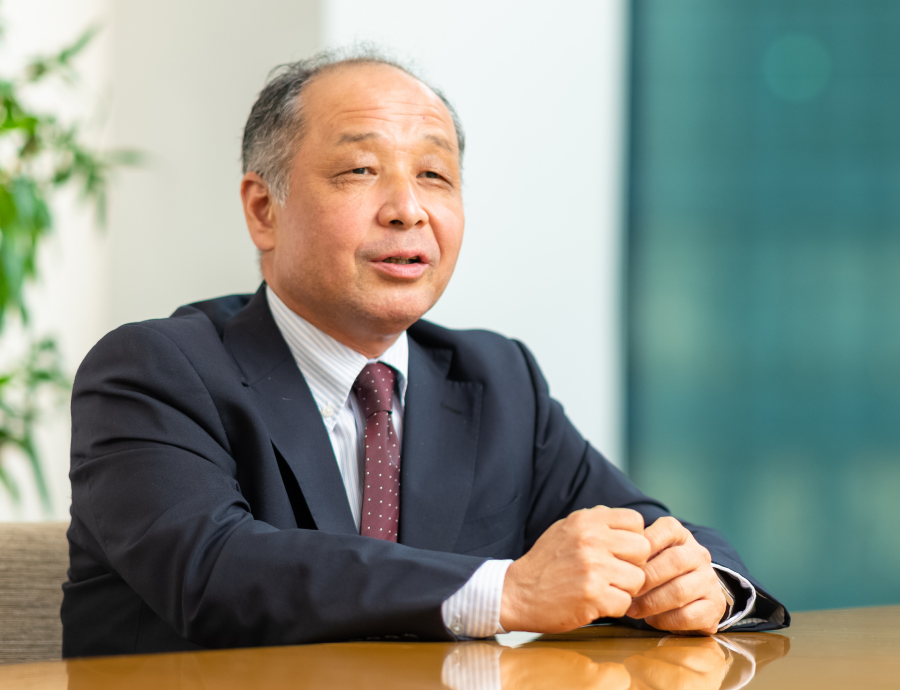
 What issues had to be addressed first through the structural reforms?
What issues had to be addressed first through the structural reforms? We had to substantially reorganize management and the divisional structure to speed up management decisions and business execution.
We had to substantially reorganize management and the divisional structure to speed up management decisions and business execution.
In my view, the main reason why the Company’s earnings power declined and the financial structure weakened was that management lacked the ability to objectively oversee the earnings capacity of each of the Group’s businesses. Accordingly, when initiating the structural reforms, we started by analyzing the weak points of our operational management and how to strengthen them. Specifically, we focused on increasing the speed and efficiency of management decision-making.
One of the biggest problems was that the number of officers in charge of business execution had increased in line with the compartmentalization of organizational functions following the Company’s establishment in 2013. Since so many officers had been appointed, the scope of their authority was not clearly defined, and more and more matters could not be decided by individual officers. As a result, time was needed to address particular issues, which led to delays in management decision-making. Indeed, this issue had been raised by the Board of Directors and the Nomination and Remuneration Advisory Committee. Therefore, after thorough deliberations, a plan was settled to substantially slim down the Company’s management team.
Our new management team was announced in February 2020 and went into effect the following April. The number of executive officers was cut from 27 to 14, clarifying the scope of responsibilities and authority of each officer and facilitating speedier decisions concerning business execution. The number of outside directors was kept at four, and the number of full-time directors who also serve as executive officers was reduced from eight to six, promoting greater separation of the execution and supervision functions of management. Through this arrangement, the Board of Directors can now engage in more dynamic discussions involving fewer members and make management decisions more quickly.
In addition, we substantially reorganized the Company’s divisional structure, which had been organized horizontally into 18 divisions under the leadership of the president. That arrangement made smooth interdivisional cooperation difficult because the operational scope and authority of the divisions were so compartmentalized. For that reason, we adopted a divisional headquarters structure divided into three new organizations: the Corporate Strategy Division, Finance and Accounting Division, and Business Support Division. Each division has a clearly defined role, which not only facilitates smooth cooperation between them but also speedier decision-making across the Group.
All of the structural reforms were approved in the Company’s general meeting of shareholders held in June 2020. They have also been very well received by institutional investors and various other groups of stakeholders.
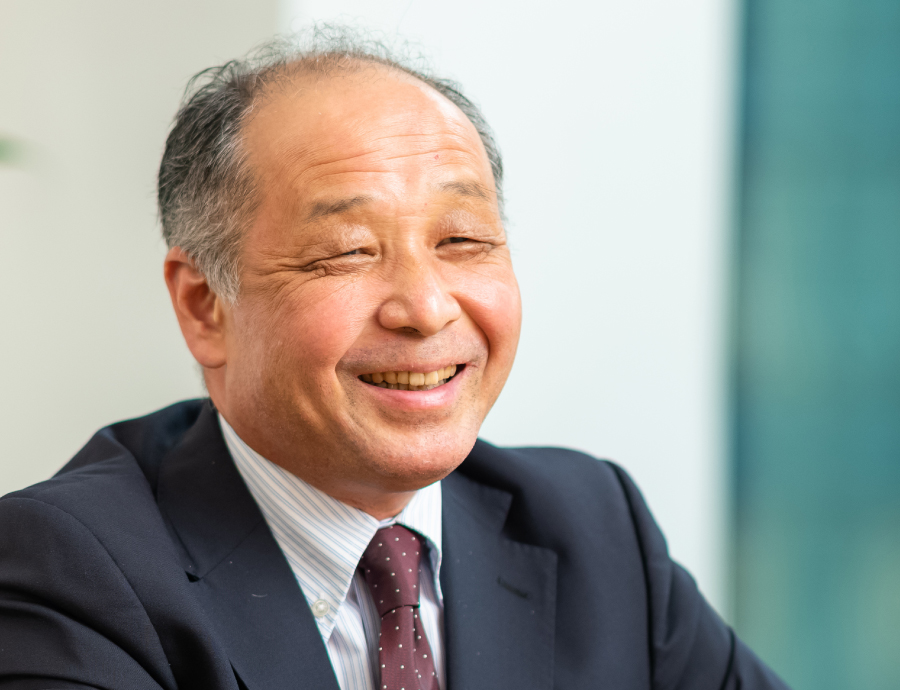
Process of formulating the structural reforms
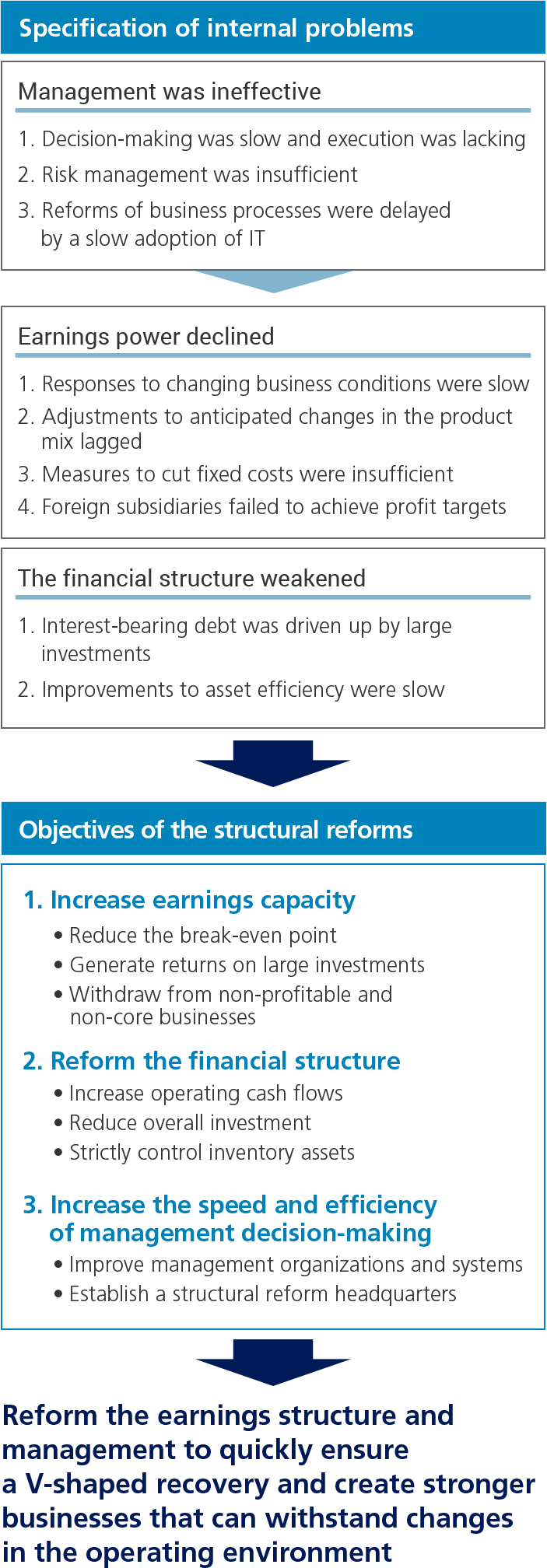
 What do you think will be the key to the success of the structural reforms?
What do you think will be the key to the success of the structural reforms? We must ensure that all members of the Group implement the reforms as a team by facilitating communication and sharing best practices.
We must ensure that all members of the Group implement the reforms as a team by facilitating communication and sharing best practices.
The structural reforms we are implementing now constitute the most extensive restructuring of the Group’s business portfolio and organizations since UACJ was established in 2013. To successfully carry out the reforms, I think the most important factor will be to keep all employees united and focused on the same objectives so their efforts and commitment are consistent.
One important objective of the structural reforms is to rationalize production plants in Japan, which will involve shutting down certain facilities and transferring operations between plants. In this process, the hardships experienced by local employees will differ widely among the plants, but those who are not directly affected should not feel happy because their workplace was spared from the rationalization. I want them to empathize with their counterparts experiencing the hardships of the reorganization, and work harder than ever to raise productivity and cut costs. Unless we continue to improve each workplace in those ways, we will not be able to actually accomplish the structural reforms.
For the reforms to be successful, all members of the Group, regardless of their job titles and responsibilities, must take individual actions toward the same goals. That means it is essential for everyone to understand the purpose and necessity of the reforms, and to move in the same direction. Therefore, revising our corporate philosophy and promoting it group-wide was a core element of the structural reforms. Toward that end, we created a program designed to promote our vision and values as the UACJ Way, which is a set of guidelines for all employees to follow. To lead these efforts, we also set up a department tasked with renewing our corporate culture. It has been creating opportunities for directors and officers, including the president, to meet with employees to discuss how the philosophy can be put into practice in one’s daily work activities.
I had also scheduled visits to various workplaces to directly speak with employees about the structural reforms and explain their importance in detail. Unfortunately, however, due to the outbreak of COVID-19, we were unable to hold large gatherings of employees. Instead, we held the meetings online and tried several digital tools to interact with employees, such as soliciting their comments and suggestions via email. I plan to continue deploying various means to explain the structural reforms to employees in the future so that we can carry them out as a united team.
Another important key for ensuring the success of the reforms is to establish best practices as soon as possible. For example, if the reforms result in an effective way to cut costs at a production plant or a useful marketing technique for stimulating new demand, I want those cases to be shared and adopted as best practices group-wide. If we share actual examples of how results were achieved by implementing the reforms, employees should be more motivated to continue carrying them out.
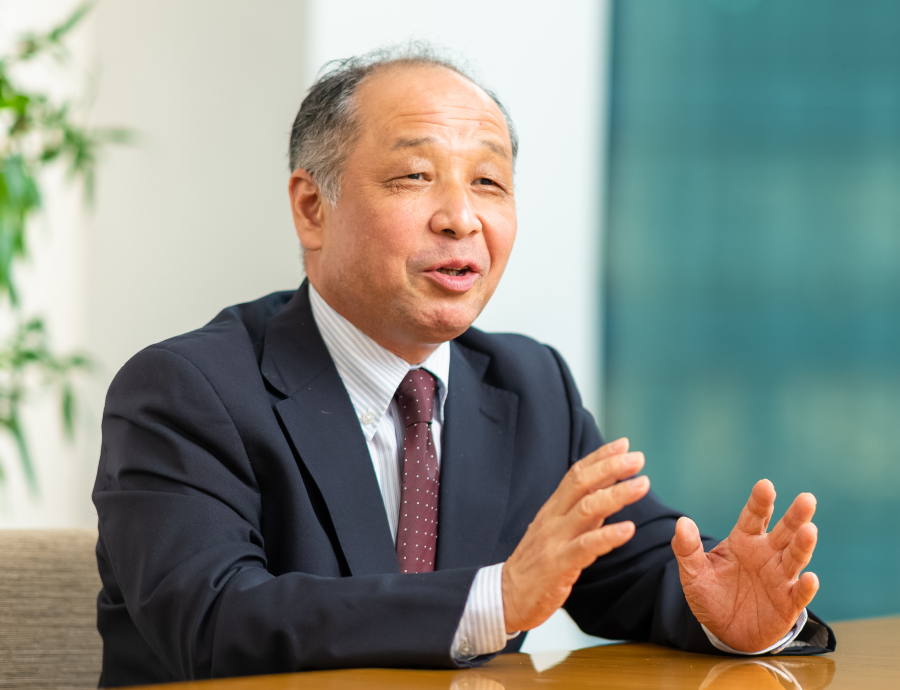
Organization for promoting the structural reforms

 How will the structural reforms move forward from now?
How will the structural reforms move forward from now? We will carefully monitor the progress and results of each measure to ensure targets are achieved.
We will carefully monitor the progress and results of each measure to ensure targets are achieved.
Through the structural reforms, we are aiming to improve ordinary income by ¥21 billion over the next three years between fiscal 2020 and 2022, ending March 31, 2023, and the entire UACJ Group is committed to this target. After the reforms were launched, COVID-19 spread worldwide beyond everyone’s expectations, but we will not let such external factors interfere with our progress. Instead, we will draw on the Group’s collective capabilities to achieve this target regardless of changes in our operating environment.
The main measures of the structural reforms have been proceeding in line with our roadmap, including the management and organizational reforms discussed above, as well as our measures for rationalizing production plants in Japan, improving earnings of overseas subsidiaries, and quickly streamlining the Group’s business portfolio. This progress has been reported in our periodic briefings of financial results, and feedback from investors and other stakeholders has consistently been positive. I understand, of course, that they are not only concerned about the flow of progress but also the specific results of the measures. Therefore, we will report in detail on whether results have been improving for each measure and how much time is expected to achieve our goals. While monitoring this progress, if any of the measures are not producing results in line with the goals, we will need to examine and quickly implement new initiatives to get the results on track.
I believe that the UACJ Group must accomplish the structural reforms if it is to fulfill its purpose of “Contribute to society by using raw materials to manufacture products that enhance prosperity and sustainability,” and in that process, continue operating as an enterprise that is indispensable for people in the future. The Group is a very large enterprise, producing over half of all flat-rolled aluminum in Japan, so a stoppage or slowdown of its operations would have various negative effects on society. Therefore, all members of the Group must always uphold our social responsibility while working together to implement the reforms going forward.
Timeline of the structural reforms
